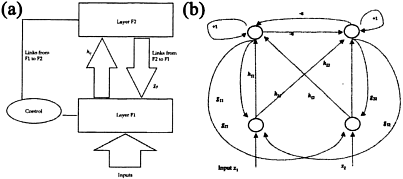40.
| [Cover] [Contents] [Index] |
Page 133
3.5 Adaptive resonance theory (ART)
Adaptive resonance theory (ART), which is a theory of human cognitive information processing (Grossberg, 1976), has led to an evolving series of neural network models for unsupervised (ART1, ART2, fuzzy ART) and supervised (ARTMAP and fuzzy ARTMAP) pattern recognition.
ART1 (Carpenter and Grossberg, 1987a) was the first ART-based model to be used for pattern recognition. It is designed to categorise binary input patterns. ART2 (Carpenter and Grossberg, 1987b) and fuzzy ART (Carpenter et al., 1991a) are extensions of the ART1 model. Both ART2 and fuzzy ART can categorise either analogue (real number) or binary input signals. ARTMAP (Carpenter et al., 1991b) and fuzzy ARTMAP (Carpenter et al., 1992) are supervised learning architectures. ARTMAP is based on two networks of the binary ART1 model, which learns binary patterns. Carpenter et al. (1992) use fuzzy ART to replace ART1 in the ARTMAP system; the resulting fuzzy ARTMAP can therefore learn analogue or binary input signals. In the following, we introduce the ART1 model to illustrate the basic concept of the ART network system. The fuzzy ARTMAP model, which is useful in classifying remotely sensed imagery, is described later.
3.5.1 Fundamentals of the ART model
An ART1 network is a self-regulating system containing two layers: the input layer (F1) and the category layer (F2), as shown in Figure 3.15a. The F1 and F2 layers are fully connected by top-down (gji) and bottom-up (hij) weighted links, which are also called long-term memory (LTM). The control unit in Figure 3.15a is used to manipulate the system mode, as described below, and this distinguishes this system from a simple Hopfield network. Each neurone in the F2 layer is self-feeding in that an output linkage connects back to the neurone itself, as shown in Figure 3.15b. A

Figure 3.15 (a) An overview of ARTI network, (b) Expanded view of ART 1 structure in the case of two neurones on each layer. See text for details.
| [Cover] [Contents] [Index] |
EAN: 2147483647
Pages: 354
- Chapter II Information Search on the Internet: A Causal Model
- Chapter IV How Consumers Think About Interactive Aspects of Web Advertising
- Chapter V Consumer Complaint Behavior in the Online Environment
- Chapter VI Web Site Quality and Usability in E-Commerce
- Chapter IX Extrinsic Plus Intrinsic Human Factors Influencing the Web Usage